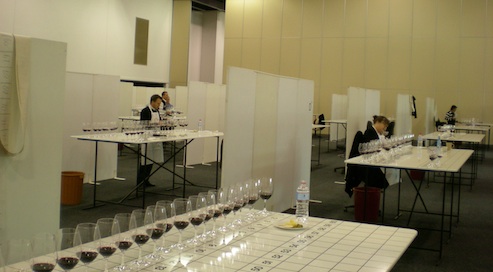
I have to admit I was a little nervous. During my second day of judging at the Royal Adelaide Wine Show, I was to asked to judge 141 red wines called the ‘Provenance class’ with two of the most highly regarded wine judges in Australia, James Halliday and Brian Croser. Halliday, an indefatigable wine critic and winemaker, has authored numerous books including the annually updated Australian Wine Companion. Both Halliday and Croser were former Chairman of Judges of major wine shows including the Royal Adelaide Wine Show. Brian Croser is a visionary and talented winemaker who influenced an entire generation of winemakers in Australia by encouraging the development of cool climate sites and seeking terroir-driven wines in Australia. I wondered whether my ‘Asian palate’ might differ dramatically from two experienced ‘Australian palates’. The two senior wine judges were brought out of retirement because of the importance of the Provenance class. This category judges not just the recent vintage but two other older vintages of the same wine; the three wines are evaluated together as a flight. By tasting three different vintages with one being at least ten years or older, it is possible to estimate their breeding, consistency, class, evolution and quality over time. Each of us had our own long table with all 141 red wines decanted and poured for us. After every 18 wines, we stopped and read out our evaluations and notes. Surprisingly, we finished in about four hours that day because there was very little to debate, no Asian versus Australian palate differences – the top wine was voted unanimously as the winner. In mid October, the winning wine in the Provenance category will be announced, but the top five finalists are all definitely worth seeking out: Majella Coonawarra Cabernet Sauvignon, Chateau Reynella McLaren Vale Cabernet Sauvignon, Eileen Hardy McLaren Vale Shiraz, Yalumba Barossa Signature Cabernet-Shiraz blend and Jack Mann Margaret River Cabernet Sauvignon. These top five wines were fantastic full-bodied complex reds with each one displaying the ability to age at least ten or more years. The Australian wine show system has come under a fair bit of criticism over the years for its bias toward ripe, bold expressions rather than delicate wines with restrained characters. With so many wines to judge, on average of 150, the potential for palate fatigue is a reality. Other criticisms according to Brian Walsh, the current Chairman of the Royal Adelaide Wine Show, include encouraging conformity of styles and the dominance of Australian winemakers who constitute the majority of wine show judges. Some of the criticisms are valid but it is clear after judging twice at the Royal Adelaide Wine Show, considered one of the most important shows in Australia, that judges are well aware of the inherent weaknesses in the show system. There is a move toward seeking more delicate wines, going for subtlety rather than flash. Most shows now invite international guest judges like myself and there are more women wine professionals and journalists who make up the judging panel. I have great admiration for the system and the quality of judges in Australia. The judges are carefully selected and are associate judges for several years before being asked to come back as judges. Most experienced wine judges participate in three to six shows per year and 150 wines a day is not really a problem. The system of having three judges on each panel works well and any wine that is rated a gold (18.5 points out of 20) by even one judge is called back so all the judges can re-taste it together. Wine shows are ingrained into the fibre of the Australian wine industry – there are seven capital city shows like the Royal Adelaide Wine Show, as well as thirty regional shows and as many new alternative shows. Thus it isn’t unusual to find an Australian wine adorned with numerous gold and silver medals on its label. To win a medal in a major show is a coup since the wine distinguished itself from a large number of wines in its category. Since wine shows began as part of the Australian agricultural show in the 1850s, the goal has remained the same: ‘Improve the breed’. By having wines judged amongst its peers by experienced judges, the medal winning wines send a clear message to producers about quality standards. Of course it helps in marketing wine to have numerous medals under its belt, but the key goal of the show is to reward those who are making benchmark wines. Adopting the Australian wine show system in traditional wine regions may be one solution to tackle the global over-supply of wine. Having wines under scrutiny every year can hopefully encourage producers to make better wine, to aspire towards a medal that is awarded by their peers. Judges who participate also get a lot out of their time – it not only gives an overview of the wine quality and styles from a particular region or category, it forces them to think carefully about how they define wine quality.
Reprinted with permission from the South China Morning Post









